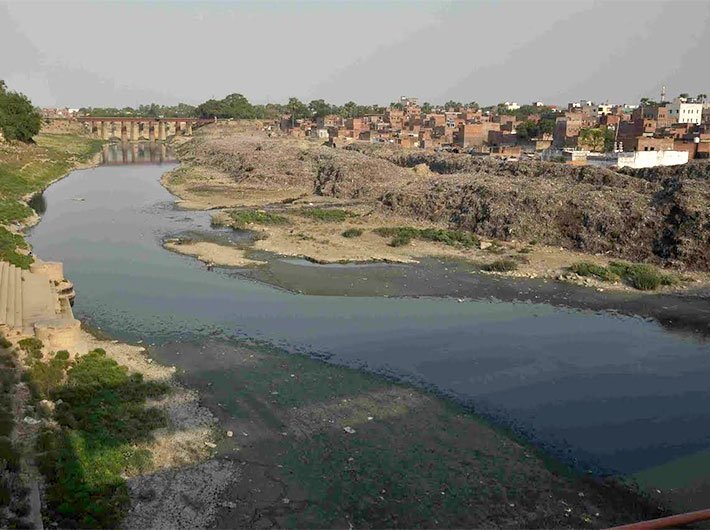The Haryana government’s overambitious effort to revive the mythical river must not happen at the cost of initiatives to clean up of India’s ailing rivers
The river Saraswati flowed steadily for over 2,000 years, before dying over 4,000 years back. The Haryana government is now intent on bringing it back to life, even as many other rivers across the country are on the verge of dying.
Markanda, Hakra, Suprabha, Kanchanakshi, Visala and Manorama are some of the names by which the once mighty river Saraswati has been mentioned in the Vedas. The Saraswati had flowed as a great river before it was obliterated in a short span of geological time through a combination of destructive natural events, according to iisc.ernet.in.
Rivers crisscross India, ensuring fertility in the rural hinterland. Undoubtedly, these rivers have played a key role in ensuring that this country of 1.2 billion people does not go to bed hungry. But, the death rattle can be heard among many of these rivers.
There are 302 polluted river stretches along 275 rivers in the country, according to a written reply in the Rajya Sabha by minister of state (independent charge) for environment, forest and climate change Anil Madhav Dave. The pollution assessment is based on the biochemical oxygen demand (BOD) levels which are the key indicators of pollution. Out of these, there are 13 stretches along rivers in Uttar Pradesh, 21 polluted stretches are in Madhya Pradesh, Gujarat has around 20 polluted stretches, while Maharashtra tops the list with 49 polluted stretches.
These sick rivers include the holiest of Indian rivers, the Ganga, which flows for over 2,500 km. But, today the river is dirty and efforts to clean it up have not yielded the desired result.
Read more about Indian rivers: http://india-wris.nrsc.gov.in/wrpinfo/?title=River_Info
The Saraswati river has religious significance as it is believed that the Triveni Sangam in Varanasi is the confluence of the Ganga, Yamuna and the invisible Saraswati.
Determined to revive Saraswati, the Haryana government on August 5 pumped 100 cusecs of water from tubewells into a dug-up channel which it believes is the route of the river.
The Indian Express reported that to make the river perennial, it is proposed to construct three dams on the Shivaliks. One will be at Adi Badri, another at Lohgarh and the third at Haripur. In future, water will be stopped at these dams to ensure continuous flow of the Saraswati.
Haryana chief minister Manohar Lal Khattar had said that as per the revenue records, around 150 km stretch of land is such where the Saraswati used to flow.
During a visit to Adi Badri in Haryana’s Yamuna Nagar district a few years back, one was left uninspired when showed a spring from which the Saraswati river is said to have emanated. There was a lot of faith, but not science to back up the claim. Apparently that has now changed.
What was perhaps more interesting were the excavations carried out by the Archaeological Survey of India. The locals had then described the excavation site as a monastery and a centre of learning.
While the Haryana government tom-toms about the Saraswati, it could well be sitting on a treasure trove of rich Indian history, if it bothers to find out more details about what the ASI experts have dug up at Adi Badri. Sometimes, one may not even realise that one may well be sitting on an exciting find that is historically significant.
Recent photographs show that Adi Badri has now been spruced up as part of an effort to develop the area.
Media reports said that satellite images had mapped the Saraswati’s course. Traces of the river are found in Kurukshetra. It is believed that the river once flowed through Thanesar, the capital of erstwhile kingdom of Harshvardhan which is located close to Kurukshetra. Legend has it that the Saraswati once fed two wells known as Kapalmochan and Ranmochan in which the Pandavas had taken bath.
While Haryana struggles to revive the Saraswati, it could well have taken lessons from India’s water man Rajendra Singh who spearheaded the effort to successfully revive five rivers in Rajasthan – Arvari, Ruparel, Sarsa, Bhagani and Jahajwali.
The Arvari river revival is an interesting project. Due to water harvesting methods, the river has become a perennial river from seasonal one. To ensure that the Arvari remains clean and healthy and also to solve internal disputes, the 70-odd villages in the Arvari basin have also formed the Arvari River Parliament.
Haryana could have perhaps done well to focus on other rivers too. And if it was so keen to revive Saraswati, it could have easily taken the help of committed people who know how to do the job well.

